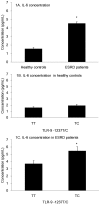Role of the functional Toll-Like receptor-9 promoter polymorphism (-1237T/C) in increased risk of end-stage renal disease: a case-control study
- PMID: 23472199
- PMCID: PMC3589433
- DOI: 10.1371/journal.pone.0058444
Role of the functional Toll-Like receptor-9 promoter polymorphism (-1237T/C) in increased risk of end-stage renal disease: a case-control study
Abstract
Inflammation induced by infectious and noninfectious triggers in the kidney may lead to end stage renal disease (ESRD). Toll-like receptor 9 (TLR-9) a receptor for CpG DNA is involved in activation of immune cells in renal disease and may contribute to chronic inflammatory disease progression through an interleukin-6 (IL-6) dependent pathway. Previous studies indicate that -1237T/C confers regulatory effects on TLR-9 transcription. To date the effect of TLR-9 polymorphisms on ESRD remains unknown. We performed a case-control study and genotyped 630 ESRD patients and 415 controls for -1237T/C, -1486T/C and 1635G/A by real-time PCR assays and assessed plasma concentration of IL-6 by ELISA. Haplotype association analysis was performed using the Haploview package. A luciferase reporter assay and real-time PCR were used to test the function of the -1237T/C promoter polymorphism. A significant association between -1237T/C in TLR-9 and ESRD was identified. The TCA, TTA and CCA haplotype of TLR-9 were associated with ESRD. ESRD patients carrying -1237TC had a higher mean plasma IL-6 level when compared with -1237TT. The TLR-9 transcriptional activity of the variant -1237CC allele is higher than the -1237TT allele. The results indicate that in a Han Chinese population the presence of the C allele of -1237T/C in the TLR-9 gene increases susceptibility towards development of ESRD. In vitro studies demonstrate that -1237T/C may be involved in the development of ESRD through transcriptional modulation of TLR-9.
Conflict of interest statement
Figures



Similar articles
-
A functional polymorphism in the promoter region of TLR3 is associated with susceptibility to end-stage renal disease.Am J Nephrol. 2014;40(2):131-9. doi: 10.1159/000365934. Epub 2014 Aug 23. Am J Nephrol. 2014. PMID: 25171218
-
The T-1237C polymorphism of the Toll-like receptor-9 gene is associated with chronic kidney disease in a Han Chinese population.Tohoku J Exp Med. 2011 Oct;225(2):109-16. doi: 10.1620/tjem.225.109. Tohoku J Exp Med. 2011. PMID: 21908957
-
The (-1486T/C) promoter polymorphism of the TLR-9 gene is associated with end-stage knee osteoarthritis in a Chinese population.J Orthop Res. 2012 Jan;30(1):9-14. doi: 10.1002/jor.21494. Epub 2011 Jul 11. J Orthop Res. 2012. PMID: 21748790
-
Association of Toll-Like Receptor 3 and Toll-Like Receptor 9 Single Nucleotide Polymorphisms with Hepatitis C Virus Infection and Hepatic Fibrosis in Egyptian Patients.Am J Trop Med Hyg. 2017 Mar;96(3):720-726. doi: 10.4269/ajtmh.16-0644. Epub 2017 Apr 6. Am J Trop Med Hyg. 2017. PMID: 28093541 Free PMC article.
-
Interleukin-1beta and receptor antagonist (IL-1Ra) gene polymorphisms and the prediction of the risk of end-stage renal disease.Biomarkers. 2006 Mar-Apr;11(2):164-73. doi: 10.1080/13547500500525383. Biomarkers. 2006. PMID: 16766392
Cited by
-
Depletion of Toll-Like Receptor-9 Attenuates Renal Tubulointerstitial Fibrosis After Ischemia-Reperfusion Injury.Front Cell Dev Biol. 2021 Feb 12;9:641527. doi: 10.3389/fcell.2021.641527. eCollection 2021. Front Cell Dev Biol. 2021. PMID: 33644078 Free PMC article.
-
Developments in renal pharmacogenomics and applications in chronic kidney disease.Pharmgenomics Pers Med. 2014 Aug 28;7:251-66. doi: 10.2147/PGPM.S52763. eCollection 2014. Pharmgenomics Pers Med. 2014. PMID: 25206311 Free PMC article. Review.
-
Innate And Adaptive Immunity are Progressively Activated in Parallel with Renal Injury in the 5/6 Renal Ablation Model.Sci Rep. 2017 Jun 9;7(1):3192. doi: 10.1038/s41598-017-02915-6. Sci Rep. 2017. PMID: 28600543 Free PMC article.
-
TLR9 -1486T/C and 2848C/T SNPs Are Associated with Human Cytomegalovirus Infection in Infants.PLoS One. 2016 Apr 22;11(4):e0154100. doi: 10.1371/journal.pone.0154100. eCollection 2016. PLoS One. 2016. PMID: 27105145 Free PMC article.
-
Reduction in the Level of Plasma Mitochondrial DNA in Human Diving, Followed by an Increase in the Event of an Accident.Front Physiol. 2018 Nov 29;9:1695. doi: 10.3389/fphys.2018.01695. eCollection 2018. Front Physiol. 2018. PMID: 30555340 Free PMC article.
References
-
- Wen CP, Cheng TY, Tsai MK, Chang YC, Chan HT, et al. (2008) All-cause mortality attributable to chronic kidney disease: a prospective cohort study based on 462 293 adults in Taiwan. Lancet 371: 2173–2182. - PubMed
-
- Satko SG, Sedor JR, Iyengar SK, Freedman BI (2007) Familial clustering of chronic kidney disease. Semin Dial 20: 229–236. - PubMed
-
- Adler S (2006) Renal disease: environment, race, or genes? Ethn Dis 16: S2-35–39. - PubMed
-
- Eleftheriadis T, Lawson BR (2009) Toll-like receptors and kidney diseases. Inflamm Allergy Drug Targets 8: 191–201. - PubMed
Publication types
MeSH terms
Substances
LinkOut - more resources
Full Text Sources
Other Literature Sources
Medical

